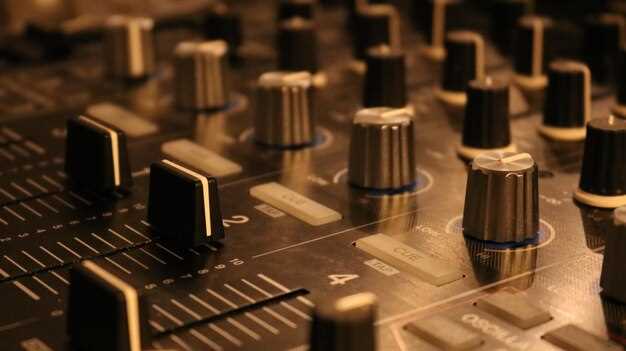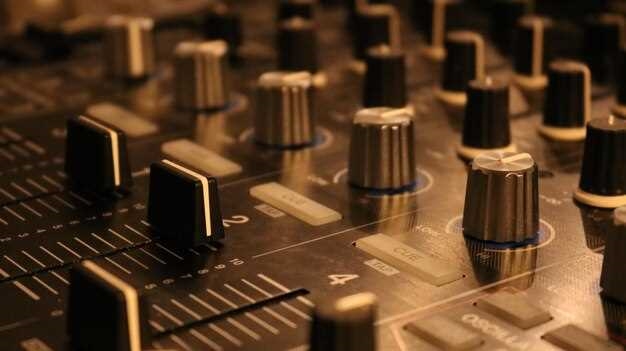
When it comes to creating an audio masterpiece that leaves listeners spellbound, it takes more than just technical prowess and ingenuity. The pursuit of perfection requires a deep understanding of the intricate mechanics that make up this cutting-edge audio device. The SC5000M’s sonic superiority is a result of the ingenious engineering techniques employed in its design and construction.
Immerse yourself in an enchanting world of sound like never before as we uncover the hidden marvels behind the SC5000M. From the meticulous selection of premium components to the meticulous fine-tuning of each individual element, this article will unveil the secrets that make this audio powerhouse stand head and shoulders above the competition.
Every detail has been meticulously considered, with the aim of delivering an unrivaled aural experience. The SC5000M’s creators have left no stone unturned, paving the way for the most discerning audiophiles to indulge in a sonic journey filled with depth, clarity, and richness. Prepare to be captivated by the sheer brilliance that emerges from this masterpiece of engineering.
The Science of Sound Reproduction
In this section, we will explore the intricate processes involved in reproducing high-quality audio on the SC5000M. Understanding the science behind sound reproduction is essential in appreciating the superior audio experience that this device provides.
Sound Waves and Frequency
One fundamental concept in the science of sound reproduction is the nature of sound waves. Sound is created through the vibration of objects, which then travel through a medium, usually air, as waves. These waves have different frequencies, which determine the pitch of the sound. The SC5000M is designed to accurately reproduce a wide range of frequencies, ensuring that every note is faithfully replicated.
Transducers and Signal Processing
Transducers play a crucial role in sound reproduction. They convert electrical signals into sound waves and vice versa. In the case of the SC5000M, advanced transducers are employed to deliver exceptional audio quality. Additionally, signal processing techniques are implemented to optimize the audio signals, minimizing distortions and unwanted noise, resulting in a pristine audio output.
| Parameter | Description |
|---|---|
| Frequency Response | The range of frequencies that the SC5000M can accurately reproduce. |
| Signal-to-Noise Ratio | The ratio of the desired audio signal to the background noise level, indicating the device’s ability to produce clear sound. |
| Total Harmonic Distortion | The amount of additional harmonics introduced in the audio signal due to imperfections in the reproduction process. |
The SC5000M’s superior audio quality can be attributed to the combination of precise transducers and advanced signal processing techniques, resulting in accurate sound reproduction with minimal distortions and optimal signal-to-noise ratio.
Understanding the Principles of Acoustics
In this section, we will explore the fundamental concepts underlying the science of sound and its transmission through different mediums. Acoustics is the branch of physics that studies how sound waves are generated, propagated, and perceived. By understanding these principles, we can gain insights into how the SC5000M achieves its exceptional audio performance.
One key concept in acoustics is the nature of sound waves. Sound is a type of mechanical wave that travels through a medium, such as air or water, as compressions and rarefactions. These waves can be described by their frequency, which determines the pitch, and their amplitude, which affects the volume. The SC5000M’s engineering leverages these principles to ensure faithful reproduction of audio with clarity and precision.
Another important aspect of acoustics is the phenomenon of resonance. When a vibrating object, such as a guitar string or a loudspeaker cone, encounters a matching frequency, resonance occurs, amplifying the sound. The SC5000M’s design incorporates advanced resonance control techniques to enhance audio reproduction and minimize unwanted distortion or interference.
Additionally, the concept of sound absorption plays a significant role in acoustics. Different materials have varying abilities to absorb sound waves, reducing echo and reverberation in a given environment. The SC5000M utilizes carefully selected materials and acoustic treatments to optimize audio performance, providing a more immersive and enjoyable listening experience.
| Key Principles of Acoustics |
|---|
| Sound waves as compressions and rarefactions |
| Frequency and amplitude as determinants of pitch and volume |
| Resonance and its role in sound amplification |
| Sound absorption and its impact on echo and reverberation |
By delving into the principles of acoustics, we can gain a deeper appreciation for the intricate engineering behind the impressive audio quality offered by the SC5000M. Understanding how sound behaves enables us to design and optimize audio systems that deliver an unparalleled listening experience.
The Role of Digital Signal Processing
Digital signal processing plays a critical role in enhancing the audio quality of devices like the SC5000M. It is instrumental in optimizing the sound reproduction and ensuring a superior listening experience. By manipulating digital signals, various aspects such as audio filtering, noise reduction, and equalization can be finely tuned to deliver exceptional audio output.
One of the key functionalities of digital signal processing is audio filtering. This involves the removal or alteration of specific frequencies in the audio signal, allowing for the elimination of unwanted noise or enhancing specific characteristics of the sound. Digital filters can be applied to selectively adjust frequencies, resulting in cleaner and more accurate audio reproduction.
Another vital aspect is noise reduction, which is achieved through digital signal processing algorithms. These algorithms analyze the incoming audio signal and identify any background noise or disturbances. By selectively reducing or eliminating these unwanted noises, the audio quality becomes more refined and immersive.
Equalization is yet another crucial function of digital signal processing. It involves adjusting the balance of frequencies within an audio signal, which allows for the optimization of tone, clarity, and overall sound quality. By carefully shaping the frequency response of the audio, the SC5000M can deliver a more natural and true-to-life listening experience.
Digital signal processing also enables advanced audio effects and enhancements. Techniques such as spatial audio processing, dynamic range compression, and surround sound simulation can be implemented to create a more immersive and captivating audio experience. These algorithms manipulate the digital signals through precise calculations and adjustments, making the audio output more dynamic and enveloping.
In summary, digital signal processing plays a pivotal role in achieving superior audio quality in devices like the SC5000M. Through techniques like audio filtering, noise reduction, equalization, and advanced audio effects, it allows for the optimization and refinement of the audio signal. The result is a truly immersive and high-fidelity listening experience that elevates the overall satisfaction of the user.
The Importance of High-Quality Components
In the realm of audio technology, the significance of utilizing components of the utmost quality cannot be overstated. These elements play a pivotal role in determining the overall sound output and performance of any audio device. From amplifiers to transducers, each component contributes to the final audio experience, making it essential to prioritize excellence in their selection.
The Role of Components in Sound Reproduction
When it comes to audio reproduction, the components used significantly impact the fidelity and clarity of the sound produced. High-quality components ensure that every detail in the audio signal is faithfully reproduced, resulting in a more immersive and enjoyable listening experience. Components with superior specifications and construction allow for precise control over frequency response, dynamic range, and distortion levels.
Enhanced Reliability and Longevity
Another advantage of high-quality components is their increased reliability and longevity. Well-engineered and durable components are less prone to failures, reducing the risk of costly repairs or replacements. These components are constructed to withstand the demands of continuous and prolonged use, ensuring that the audio device maintains its superior performance over an extended period.
Minimizing Signal Interference and Distortion
Poor-quality components, such as subpar cables or connectors, can introduce signal interference and unwanted distortion into the audio path. High-quality components, on the other hand, are designed to have minimal internal resistance, impedance, and crosstalk, ensuring a clean and accurate signal transmission. By minimizing signal degradation, these components preserve the integrity of the audio signal from source to output, resulting in a more faithful and transparent sound reproduction.
Achieving the Desired Sound Signature
The choice of components also influences the overall sound signature that an audio device delivers. Different components exhibit distinct characteristics that can significantly impact the tonal balance, warmth, and richness of the audio output. Selecting high-quality components allows engineers to carefully tune and shape the sound quality to achieve the desired sonic characteristics, satisfying the preferences of audiophiles and professionals alike.
In conclusion, the importance of high-quality components in audio technology cannot be underestimated. These elements are crucial for achieving superior sound reproduction, enhancing reliability, minimizing interference and distortion, and attaining the desired sound signature. By prioritizing excellence in component selection, audio devices can provide an immersive and high-fidelity audio experience that truly captivates the listener.
Pushing the Boundaries of Audio Engineering
Exploring the frontiers of sound and innovation, this section delves into the fascinating domain of audio engineering, where boundaries are continually pushed in the pursuit of exceptional auditory experiences. Unearthing groundbreaking techniques and revolutionary approaches, we delve into the art of crafting mesmerizing soundscapes that captivate the senses.
In this realm of endless possibilities, audio engineers transcend the conventional norms to experiment with novel technologies, inventive methodologies, and avant-garde concepts. By pushing the boundaries of what is deemed possible, they strive to redefine the very essence of audio quality, opening new realms of immersion and audio realism.
- Exploring Uncharted Territories: Unraveling the unexplored intricacies of sound reproduction
- Revolutionary Signal Processing: Harnessing the power of cutting-edge algorithms and signal manipulation
- Unveiling the Sonic Secrets: Uncovering the mystique behind sonic illusions and psychoacoustics
- Forging New Soundscapes: Merging technology and artistic expression to craft unparalleled audio experiences
- The Future of Audio: Anticipating emerging trends and innovations in the world of sound engineering
Throughout this journey, we aim to shed light on the relentless pursuit of perfection by audio engineers, as they strive to surpass expectations and transcend conventional limitations. Join us as we unravel the fascinating world of audio engineering and witness the exceptional possibilities that lie beyond.
Innovative Techniques in Turntable Design
In this section, we will explore the groundbreaking approaches employed in the design of modern turntables. These pioneering methods revolutionize the way music is experienced and bring forth a new era of audio pleasure.
One of the remarkable advancements in turntable design is the implementation of cutting-edge technologies that enhance audio fidelity and reproduce sound with unparalleled clarity. By incorporating innovative techniques, engineers have succeeded in creating turntables that deliver an immersive sonic experience like never before.
Additionally, the use of state-of-the-art materials and meticulously engineered components has allowed for the production of turntables that are both aesthetically pleasing and highly functional. The integration of these advanced materials ensures superior durability and impeccable performance, making modern turntables a testament to meticulous craftsmanship.
Furthermore, the development of advanced motor and drive systems has greatly contributed to the overall performance of turntables. Through the utilization of innovative motor technologies, engineers have achieved precise rotational speed control, minimizing speed variations and guaranteeing accurate playback of music.
Another noteworthy innovation in turntable design is the incorporation of advanced tracking systems. These cutting-edge systems utilize sophisticated sensors and algorithms, enabling precise tracking of the record grooves and minimizing distortion. As a result, listeners can enjoy an authentic and immersive listening experience free from any unwanted artifacts.
Overall, the use of pioneering techniques in turntable design has redefined the boundaries of audio quality and transformed the way we engage with music. Through a relentless pursuit of engineering excellence, modern turntables have become a harmonious blend of innovation, artistry, and the ultimate quest for sonic perfection.
The Advantages of Dual-Layer Playback Technology
Dual-layer playback technology offers a multitude of benefits that contribute to enhanced audio performance and user experience. By incorporating innovative engineering techniques, this advanced feature elevates the capabilities of the SC5000M music player to deliver a superior sound quality that captivates listeners.
1. Enhanced Audio Fidelity
One of the primary advantages of dual-layer playback technology is its ability to provide improved audio fidelity. By utilizing dual layers within the player, the audio signal is processed with increased precision and accuracy. This results in a richer, more detailed sound reproduction, ensuring that every note and nuance is faithfully reproduced.
2. Seamless Transition
Another key advantage of dual-layer playback technology is its seamless transition between different audio sources. With this advanced feature, the SC5000M seamlessly switches between both layers, eliminating any gaps or interruptions in the audio playback. This ensures a smooth and uninterrupted listening experience, allowing the music to flow seamlessly from one track to another.
In conclusion, dual-layer playback technology on the SC5000M brings a range of advantages, including enhanced audio fidelity and seamless transitions. Through these innovative engineering techniques, the SC5000M sets a new standard in audio quality, revolutionizing the way we experience music.






+ There are no comments
Add yours